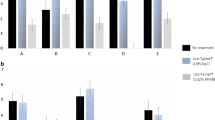Abstract
Many patients undergoing long-term bladder catheterisation experience blockage and encrustation of their catheters. The problem stems from infection by urease producing bacteria, particularly Proteus mirabilis. Bacterial biofilms colonise the catheters, the activity of urease raises the pH and induces the deposition of calcium and magnesium phosphate crystals. In this study, a laboratory model of the catheterised bladder has been used to examine the early stages in the formation of the crystalline biofilms. The results show that initial cell adhesion is to the irregular surfaces surrounding the catheter eye-holes. Microcolonies form in depressions in these surfaces and spread to cover the entire surface of the rims around the eye-holes. Crystals then form around the bacterial populations and the biofilm starts to move down the lumenal surfaces of the catheters. The encrustation develops most extensively and generally blocks the catheter at or just below the eye-hole. There is a need to improve catheter design and manufacturing procedures for the eye-holes if the problems associated with the current devices are to be reduced.








Similar content being viewed by others
References
Axelsson H, Schönebeck J, Winblad B (1977) Surface structure of unused and used catheters. Scand J Urol Nephrol 11: 283
Bull E, Chilton CP, Gould CAL, Sutton TM (1991) Single-blind, randomised, parallel group study of the Bard Biocath catheter and a silicone elastomer catheter. Brit J Urol 68: 394
Cools HJM, Van der Meer JWM (1986) Restriction of long-term indwelling urethral catheterisation in the elderly. Brit J Urol 58: 683
Cox AJ (1990) Comparison of catheter surface morphologies. Brit J Urol 65: 55
Dumanski AJ, Hedelin H, Edin-Lijegren A, Beauchemin D, McLean RJC (1994) Unique ability of Proteus mirabilis capsule to enhance mineral growth in infectious urinary calculi. Infect Immunol 62: 2998
Griffith DP, Musher DM, Itin C (1976) Urease: the primary cause of infection-induced urinary stones. Invest Urol (Berl) 13: 346
Kohler-Ockmore J, Feneley RCL (1996) Long-term catheterisation of the bladder: prevalence and morbidity. Brit J Urol 77: 347
Kunin CM (1987) Detection, prevention and management of urinary tract infections, 4th edn. Lea and Febiger, Philadelphia
Kunin CM (1988) Can we build a better urinary catheter? N Engl J Med 319: 365
Kunin CM (1989) Blockage of urinary catheters: role of microorganisms and constituents of urine on the formation of encrustations. J Clin Epidemiol 42: 835
Kunin CM, Chin QF, Chambers S (1987) Formation of encrustations on indwelling catheters in the elderly. J Urol 138: 899
Mobley HLT, Warren JW (1987)Urease-positive bacteriuria and obstruction of long-term urinary catheters. J Clin Microbiol 25: 2216
Morris NS, Stickler DJ, Winters C (1997) Which indwelling urethral catheters resist encrustation by Proteus mirabilis biofilms? Brit J Urol 80: 58
Morris SN, Stickler DJ, McLean RJC (1999) The development of bacterial biofilms on indwelling urethral catheters. World J Urol 17: 345
Stickler DJ, Zimakoff J (1994) Complications of urinary tract infections associated with devices used for long-term bladder management. J Hosp Infect 28: 177
Stickler DJ, Ganderton L, King J, Winters C (1993) Proteus mirabilis biofilms and the encrustation of urethral catheters. Urol Res 21: 407
Talja M, Ruutu M, Andersson LC, Alfthan O (1986) Urinary catheter structure and testing methods in relation to tissue toxicity. Brit J Urol 58: 443
Warren JW (2001) Catheter-associated urinary tract infections. Int J Antimicrob Agents 17: 299
Author information
Authors and Affiliations
Corresponding author
Rights and permissions
About this article
Cite this article
Stickler, D., Young, R., Jones, G. et al. Why are Foley catheters so vulnerable to encrustation and blockage by crystalline bacterial biofilm?. Urol Res 31, 306–311 (2003). https://doi.org/10.1007/s00240-003-0340-3
Received:
Accepted:
Published:
Issue Date:
DOI: https://doi.org/10.1007/s00240-003-0340-3




